I’m going to be a bit oblique in the way I get into discussing Wes Anderson’s beautiful, enigmatic film, Asteroid City (2023). But then, being oblique has never scared Mr. Anderson, so wot da hey, lemme go with it.
We like to think that art can be a powerful scourge against the forces of hate, and ignorance, and violence. This isn’t always true. Both the Marx Brothers and Charlie Chaplin dared to take on Adolf Hitler with, respectively, Duck Soup (1933) and The Great Dictator (1940), only to discover that literate anarchy and Little Tramp-style hijinks were meagre weapons to deploy against true evil. Pablo Picasso poured every ounce of rage he could summon into documenting a Spanish atrocity in his brilliant painting Guernica (1937), yet the passage of time has so obscured its intent that one especially tone-deaf cartoonist recently used the work to crack a feeble joke about the artist using aliens as models.
So what is art’s superpower?
Taking another route: There have been two remakes of the original King Kong (1933— is there a pattern, here?). The most recent, released in 2005, was directed by Peter Jackson and featured a computer-generated Kong. Conjured by premiere CG studio Wētā FX, Jackson’s Kong is a masterpiece of special effects, a fully believable creature that completely integrates with his surroundings and is given soul by virtuoso motion-capture actor Andy Serkis.
And yet, I would argue that the original Kong, stop-motion animated by Willis H. O’Brien, is the more compelling figure. Further, the relative crudeness of O’Brien’s Kong, instead of being a hindrance to audience connection, may actually be its impetus. We look at Jackson’s Kong and go, “Yup, there he is.” But with O’Brien’s Kong, the jerkiness, the occasional awkwardness, the fact that you can practically sense the animator’s hand manipulating his stop-motion figure, activates something in us, turns us from passive viewers into willing participants. We fill in the gaps of the performance, and in the process make it more real. Abstraction, as a certain Spanish artist would insist, can connect to us more deeply than reality.
In Asteroid City, the 1955 viewing of a celestial event by a clutch of young inventors—along with their parents and guardians, some scientists, and the military—is disrupted by the arrival of an alien spaceship that hovers over the desert-bound meteorite impact crater within which the participants are gathered. As the stunned humans watch, an alien descends from the ship on a spindly, pipe-like elevator, carefully plucks up the meteorite that formed the crater some five millennia ago and, after obligingly posing to have its picture taken with its trophy, ascends back into the ship and tootles off toward the horizon.
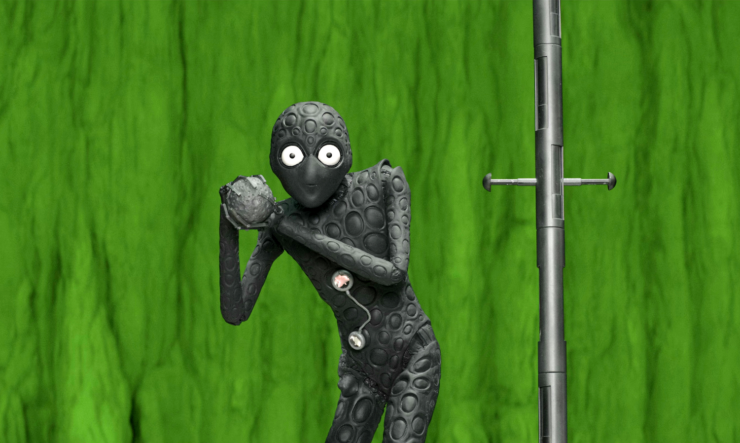
There is nothing real about that alien. It is a stop-motion animated figure, modeled on a performance by Jeff Goldblum (and once you know that, you can look at the figure and say, “Oh yeah, that’s him”). And the sheer, deliberate artificiality of the moment somehow conveys its magic more fully than could any painstaking attempt to render it real.
But that applies in general to the work of Wes Anderson. As with many of his previous projects, there is nothing especially natural in Asteroid City. The precise camera moves, the tableau-like character arrangements, the bright, pastel production design, the deliberation with which the characters speak (the script was co-written by Anderson and Roman Coppola)—all of it pulls us away from our perceived reality into Anderson’s stylized one.
Even the structure of the film drives us away from the real. Set in the mid-fifties, Asteroid City is presented as a TV reenactment of how a play—also named, not-so-coincidentally, Asteroid City—gets produced. In luminous, mostly black and white sequences, we see the play’s author, Conrad Earp (Edward Norton) struggle with his creation; we see the interpersonal travails of its director, Schubert Green (Adrien Brody) and some of its stars (Jason Schwartzman and Scarlett Johansson).
And we see the play itself, but not as a play. Instead, it’s the play as it exists within Anderson’s interpretation: Set in an actual desert (filmed on location in Spain); enhanced with charmingly stylized special effects, and populated with a fair portion of Anderson’s stock company (sans Bill Murray) plus a hefty portion of high-profile newcomers. So in essence what we are watching is a TV documentation of the creation of a play that presents itself as a movie, but with play-like scene and act breaks. The layers of narrative abstraction are mind-boggling.
As is the narrative overall. Anderson is no stranger to cramming his films with characters intent on their own agendas, but here the population is broad and dazzling. The main characters, if any could be called that, are war photographer Augie Steenbeck (Schwartzman) and his teenage son and budding inventor Woodrow (Jake Ryan). They have come to the desert-bound bus-line way station of Asteroid City, located somewhere vaguely around Arizona, California, or Nevada (or for all I know, on the border of all three), to participate in Asteroid Day, the annual celebration of the impact of the small, pitted rock that formed the town’s crater in 3007 BC. In addition, there will be the viewing of a rare astronomical ellipses—a kind of “celestial flirtation,” as resident astronomer Dr. Hickenlooper (Tilda Swinton) notes—and the awarding of ceremonial ribbons and a generous scholarship to an assembled group of “Junior Stargazers and Space Cadets” for their various inventions. (Woodrow’s is a device for projecting photographic slides on the surface of the moon—“It may have applications in the development of interstellar advertising”).
Also among those arriving at the spare little town (notably marked by an abandoned highway overpass that starts nowhere and leads nowhere) is film actress Midge Campbell (Johansson)—whose preparations for her next role seem to have tragic resonances to her own life—and her daughter Dinah (Grace Edwards), whose invention accelerates the growth of plants but also renders them toxic. The two women form bonds with the elder and junior Steenbecks, possibly because Augie, Woodrow, and Woodrow’s three sisters, the triplets Andromeda, Pandora, and Cassiopeia (actual triplets Ella, Gracie, and Willan Faris) share their own tragedy: Augie’s wife has died. She passed away several weeks earlier, and the courageous war photographer, with the shrapnel wounds to show for it, has dragged his feet in informing his children.
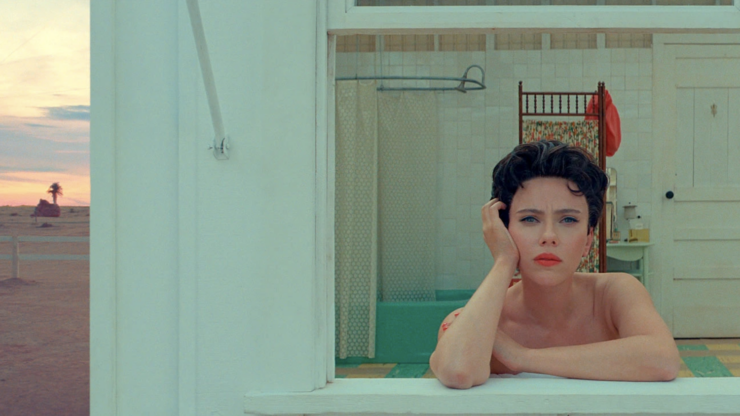
Once they find out, the sisters—little bundles of infantile anarchy who had previously been seen obsessing over roadkill and throwing rocks at abandoned cars—will attempt to resurrect their mother by chanting a spell and burying her Tupperware-enshrined ashes near the communal showers of the town’s motel. They then pitch a holy fit—“If you torture us, we’ll sacrifice you,” one of them solemnly intones in possibly the film’s best line—when their wealthy grandfather (Tom Hanks) suggests that he bring the remains to a more fitting resting place. (Since he’s thinking of the golf course on his property, that’s a matter of perspective.) Woodrow, for his part, will join forces with the other Junior Stargazers to break the communications quarantine the government imposes following the alien visitation, in an effort to inform the world of the existence of extraterrestrial life (Wes Anderson children may be the only ones in cinema fully deserving of the term “intrepid”), while Augie strikes up a tenuous flirtation with Midge and, after having finally slept with her, willfully burns his hand on a hot plate, much to the confusion of Jones Hall, the actor—also played by Schwarztman—playing the role of Augie.
And here’s the paradox, shared pretty much by all of Anderson’s films: For all the artificiality of the mise en scene, for all of the carefully crafted dialogue and razor-precise staging, the emotions feel real. Or maybe it’s not in spite of, but because. Anderson’s abstractions give us room to interact with the characters, fill in the spaces in their motivations. The actors—the ones we see being portrayed in the TV recreation—may occasionally be befuddled by their roles, but we instinctually understand. Anderson’s and Coppola’s writing, and the actual performances of a top-notch cast, have given us all we need to make sense of their actions.
Wes Anderson’s work has frequently been described as dreamlike. That’s emphatically true of Asteroid City. Studies show that dreams are not coherent narrative, but random assemblages of images, events, sensations. We only remember dreams if we awaken in their midst; and we only think of them as narratives upon awaking, when our pattern-finding instinct kicks in. Asteroid City overteems with seemingly random events—I haven’t mentioned the one Junior Stargazer (Aristou Meehan) whose repeated entreaties to be dared into risky acts is a desperate plea for attention; or the weird, autobiographical and inappropriately graphic speech the commander of the military outpost (Jeffrey Wright) delivers to the Junior Stargazers (and Space Cadets); or the automobile that apparently daily speeds through town, chased by a motorcycle cop and a police car; or the fact that this PG-13 film has a surprising moment of nudity; or that the narrator of the TV reenactment (Bryan Cranston) abruptly shows up in one scene of the “play,” only to shuffle awkwardly off-screen.
It is, like dreams, a wild assemblage of the disparate. But that seems to be Anderson’s intent. At one point during the TV recreation, the play’s author, Conrad Earp (Edward Norton) visits the acting class of Saltzburg Keitel (Willem Dafoe). He seeks the students’ help in refining a passage in the play where, as he puts it, “all my characters are each gently, privately seduced into the deepest, dreamiest slumber of their lives.” Spurred by the concept, Keitel begins speculating on scenarios that arise out of a good night’s sleep, suggesting that Earp could “wake up with a new scene three-quarters written in your head…” (As an aside, more than a few writers can attest to how bringing a roadblock to bed with you can lead to a solution by morning. In fact, it’s the way I broke the logjam that kept me from tackling this piece.)
In positing such a scenario, it is possible Anderson is commenting on his own creative process, maybe even addressing his critics by declaring how he views his works, and how we should as well. But later in the film, during a continuation of the scene, actor Jones Hall—who’s auditing the class—leaps to his feet and declares, “You can’t wake up if you don’t fall asleep.” The rest of the class picks up the mantra, joined by Earp, Keitel, and Schubert Green, who all gather around the alien—now seemingly portrayed by Goldblum in costume—as it offers up the meteorite to the camera.
There’s been a lot speculation about what this moment means. I don’t think it’s particularly off-base to suspect that Anderson, having written himself into a corner, threw his hands up and created the classroom sequence as a way of saying, “Well, we’ve all had our fun, but now it’s time to get out of our theater seats, deposit all trash in the appropriate receptacles, and get back to our lives.” Maybe though, that’s too glib. Maybe instead of an artist working his way out of a dead-end, it’s Anderson finding a pathway to something deeper.
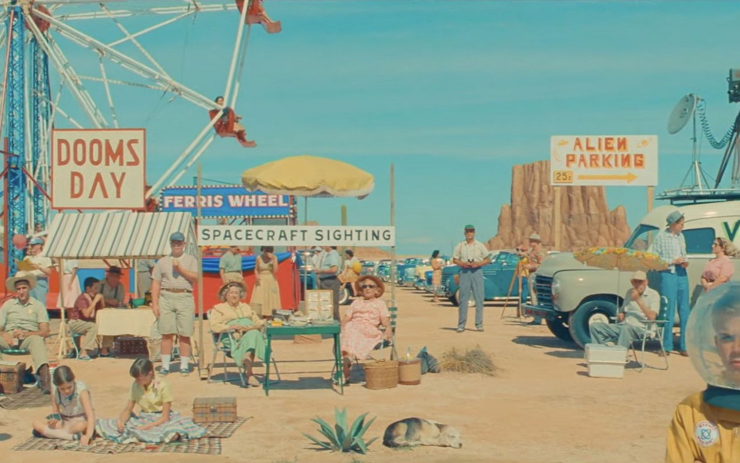
Hollywood used to be called the Dream Factory, and there’s a lot about the experience of viewing a movie that parallels what happens within our brains during slumber. We are engulfed in darkness, as imagery is magically conjured before our eyes. The logic of those images may be readily apparent, or we may have to puzzle out their meaning, possibly even after we leave the theater, after we “awaken.” Even the process of film editing, where unrelated images can be juxtaposed to synthesize new meaning, mirrors the mechanics of dreams.
But there is something important to keep in mind about dreams, about film, about art in general: They in themselves have no tangible impact on the world. They are representations, stylizations, shadows upon a screen. A notable parallel between Anderson and classic Hollywood is that by dint of the unwieldy equipment needed to spin all those dreams back then, Golden Age cinema was all artifice—sets on a soundstage, backlot cities, elaborate makeup and costumes tailored to please the lens.
Art by itself cannot topple dictators, or reverse global warming, or feed the starving. But it is also something, I think, we need. We need the artifice, we need the abstraction. We need the openings that lead us to look beyond the work itself, into a consideration of our own condition, and the condition of the world around us. We need to “fall asleep,” to dream, so that we can finally awaken, enriched, and with a better appreciation of who we are, and what we need to do. (Something school board members need to keep in mind as they consider slashing the budgets of arts programs.)
Notably, Anderson doesn’t bookend Asteroid City by leading us out of the film, out of the play, out of the reenactment, and back into the TV studio. In the final scene—the “epilogue,” from the perspective of the play—all the Asteroid Day participants have left town, leaving only the extended Steenbeck family to pack up and head off to a future where the only certainty is that they’re deprived of the woman who once shared their lives. They are emerging from the isolation of their dream experience, into a reality that may or may not now be altered by what they have undergone. Ideally, they have grown upon their awakening. Anderson, though, leaves that open to speculation; one final gap for us to fill in.
* * *
I’m unabashed in saying that Asteroid City is one of my favorite films of the year, if not the favorite. I also will not deny that I may be completely off-base in my interpretation of the film, and what Anderson might be trying to say. And that’s why there’s a humble little comments section—right down there—in which you can hold forth. We want to hear your thoughts on this beguiling film, good, bad, or downright wacky. As always, let’s be nice to each other—this is a dream we share, after all.
Dan Persons has been knocking about the genre media beat for, oh, a good handful of years, now. He’s presently house critic for the radio show Hour of the Wolf on WBAI 99.5FM in New York, and previously was editor of Cinefantastique and Animefantastique, as well as producer of news updates for The Monster Channel. He is also founder of Anime Philadelphia, a program to encourage theatrical screenings of Japanese animation. And you should taste his One Alarm Chili! Wow!




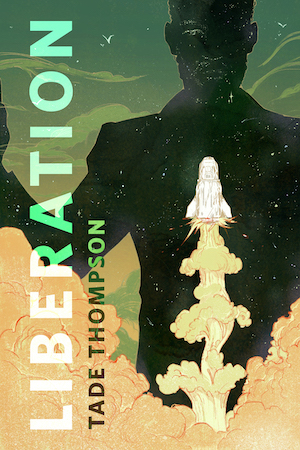





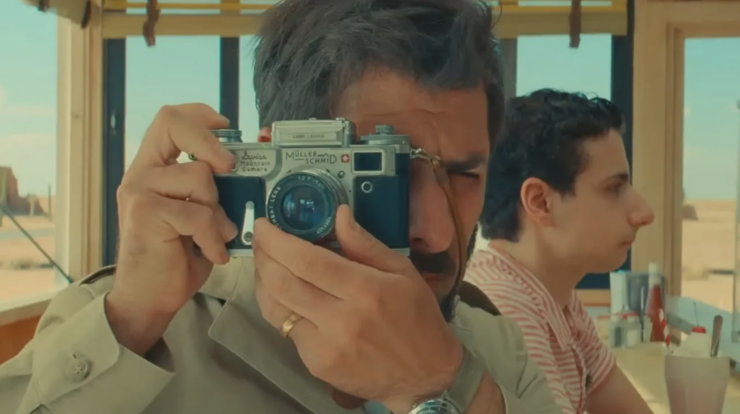
Art is the stuff that dreams are made of.
Something I particularly enjoyed about Asteroid City is the way the most emotionally tender, touching exchange in the film is removed several times over from any sense of reality or immersion.
To have the dream reunion with his wife Augie has to leave the world of the film Asteroid City via the ‘making of the play’ tv documentary, leave the theatre itself and converse with an actress in another theatre across a fire escape who was cut from the play, and not even recite his own lines. She remembers them for him.
And despite being so removed, so obviously contrived, the full artificiality of the film making process completely exposed and in your face, it’s deeply, deeply affecting.
In an age where it feels people are very literal about their culture and value immersion in the imagined world above everything else, it was a very welcome moment, showing we connect with the actors, with the ideas, with the story, even when it keeps telling you it’s made up.
Mediation. It brings us closer to the truth of things. Anderson shines surfaces to reveal their superficiality.
Sadly I’m a nay-sayer on this film. Trailer looked interesting, the director and actors looked promising, I’m not fussed by odd looks at things, and I don’t need a plot tossed in my face. I wasn’t fussed by the “unreal alien.”
I just kept waiting for it to get interesting, and it seemed like every time it inched towards that, it fell back towards boring.
There were a few clever bits with Scarlett, the 4 Science finalists probably had the best of it along with the 3 kiddies. I left the theatre more upset for the time I had lost than the cost of the ticket.
Interesting article. It’s possibly my favorite Wes Anderson film – just so cleverly constructed and beautifully filmed. I had seen the exhibition of sets and props from the film in London before I went and that really enhanced the experience.
I watched the movie last night on Netflix and LOVED it — despite the fact that I was confused by a good part of it. I searched for a review that might explain some of what eluded me and, in a great stroke of luck, came across Dan’s thoughtful review. This paragraph, near the end, put everything in perspective for me and validated my loving something I couldn’t quite understand: “Hollywood used to be called the Dream Factory, and there’s a lot about the experience of viewing a movie that parallels what happens within our brains during slumber. We are engulfed in darkness, as imagery is magically conjured before our eyes. The logic of those images may be readily apparent, or we may have to puzzle out their meaning, possibly even after we leave the theater, after we ‘awaken.’ Even the process of film editing, where unrelated images can be juxtaposed to synthesize new meaning, mirrors the mechanics of dreams.” Thank you, Dan. That was a great review!
Yeah, you almost got it. The key is that the entire film IS a dream. In this, it reminds me of Ishiguro’s novel “The Unconsoled.” This actually explains every strange thing in the movie. The character who is closest to being a “stand-in” for the dreamer is Conrad, the playwright. But, as in every dream, all the characters are really the dreamer, most especially the alien. I’m about to write an article about this on my blog, Lake Ivan Film Journal.